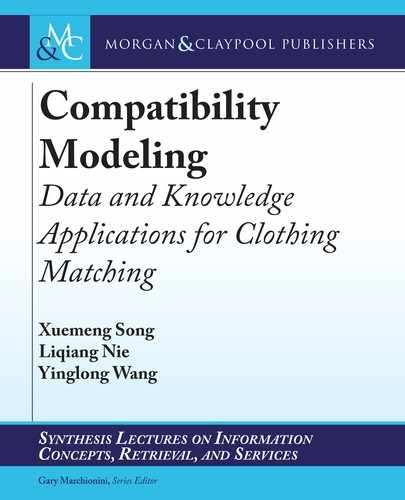1.3. OUR SOLUTIONS 3
ird is the model interpretability. To comprehensively fulfill the clothing matching task,
the compatibility modeling scheme should not only give the final decision on whether or not
the given fashion items are compatible, but also interpret the discordance of incompatible out-
fits. Nevertheless, most existing studies focus more on employing deep learning methods to
learn effective representations for fashion items, and hence suffer from the poor interpretabil-
ity, making them less useful in practice. Accordingly, how to enhance the interpretability of the
compatibility modeling scheme proves difficult.
Fourth is the user factor. In reality, different people may have different fashion tastes, and
their aesthetics can be rather subjective. For example, given a T-shirt, some people prefer jeans
to make an outfit, while others may like skirts. Additionally, people with different body shapes
tend to go with different types of fashion items, to highlight their figure strengths and weaken
the shortcomings. Consequently, how to incorporate the user factor, such as personal preference
and body shape, in the traditional item-based compatibility modeling framework, making the
matching results not only of high compatibility from the general item-item perspective but also
cater for user taste as well as body shape from the personal item-user angle, contributes a crucial
challenge.
e last challenge is the absence of a comprehensive benchmark. In fact, several fash-
ion datasets have been collected in existing studies, for example, the WoW [76], Exact
Street2Shop [29], and Fashion-136K [49]. However, most existing released datasets mainly in-
clude the visual metadata of fashion items but lack the contextual description, as aforementioned,
which also comprises a great deal of valuable information on items. In addition, the user context
is usually absent from most existing released datasets in the fashion domain, which hinders the
research on integrating the user factor into the compatibility modeling. erefore, it is necessary
to construct comprehensive benchmark datasets to fulfill the validation of compatibility models.
Furthermore, several other issues come into being, such as the confidence of various
knowledge rules in the guidance of compatibility modeling, user preference modeling, and user
body shape factor in compatibility modeling, which increase the challenge of the proposed prob-
lem.
1.3 OUR SOLUTIONS
To address the aforementioned research challenges, we present several state-of-the-art compat-
ibility modeling theories and verify them in different contexts, ranging from the general com-
patibility modeling, personalized compatibility modeling to personalized wardrobe creation.
To facilitate the evaluation of our proposed schemes, we first created three large-scale
real-world datasets from several online fashion-oriented communities for the above three tasks,
respectively. In particular, Dataset I is created by collecting the outfit compositions of fashion
experts on Polyvore. Considering that it lacks enough user context, we build Dataset II by crawl-
ing the historical outfits of 6,191 users from IQON. en to incorporate the user’s figure/body
shape and create suitable user wardrobe, we build Dataset III comprising purchase histories of
4 1. INTRODUCTION
11,784 users on Amazon. e underlying philosophy is that, in a sense, the user body shape can
be derived from the sizes of his/her purchased fashion items.
For the general compatibility modeling, we first introduce a data-driven compatibility
modeling scheme with neural networks, where both modalities of fashion items are exploited.
e core is to find the latent compatibility space which can bridge the gap between comple-
mentary fashion items from heterogeneous spaces and facilitate the compatibility measurement
between items. Toward this end, we resort to the advanced neural networks to capture the sub-
tle compatibility factors, like color, material, and pattern. Finally, the Bayesian Personalized
Ranking (BPR) framework is adopted to exploit the implicit pairwise preference between com-
plementary fashion items.
In fact, as an essential aspect of people’s life, the fashion domain has accumulated rich
human knowledge on clothing matching. To boost the performance, we then present a novel
knowledge-guided compatibility modeling framework, which is able to learn the latent com-
patibility space from not only the specific data samples but also the general domain knowledge.
In particular, we adopt the teacher-student scheme, where the teacher network can guide the
student data-driven learning network with the domain knowledge, namely, the clothing match-
ing rules. Considering that different knowledge rules may have different confidence in guiding
different sample pairs, we employ the attention mechanism to adaptively assign the rule confi-
dence.
To enhance the model explainability, we devise a prototype-wise interpretable compat-
ibility modeling scheme, based on the key assumption that compatible fashion items tend to
follow certain underlying harmonious attribute interaction prototypes, while the incompatible
ones would like to share some unfavorable prototypes. e proposed scheme seamlessly unifies
the compatibility modeling and latent prototype learning, where the non-negative matrix fac-
torization technique is employed to discover the latent prototypes. e learned prototypes can
be regarded as the templates to interpret the discordant attribute and suggest the alternative
ones.
To deal with the user factor in compatibility assessment, we then propose a personalized
compatibility modeling scheme between fashion items with the user factor taken into account.
In particular, the proposed scheme consists of two essential components: general compatibility
modeling and personal preference modeling. In particular, apart from the traditional item-item
interaction, user-item interaction (i.e., the user’s preferences on fashion items) is captured with
the matrix factorization framework. To comprehensively model the user preference, the latent
preference factors on both modalities of fashion items are introduced.
As mentioned previously, user body shapes can also affect the compatibility modeling
in a sense. People with different body shapes would go with different types of clothing items.
Meanwhile, each outfit usually involves more than two pieces of fashion items. Toward this
end, we further present a combinatorial optimization-based personalized compatibility model-
ing paradigm for outfits with the real-world application of personalized capsule wardrobe cre-
..................Content has been hidden....................
You can't read the all page of ebook, please click here login for view all page.
